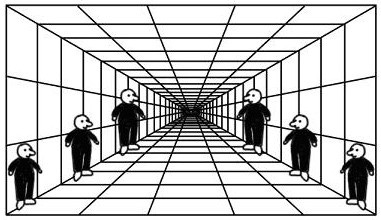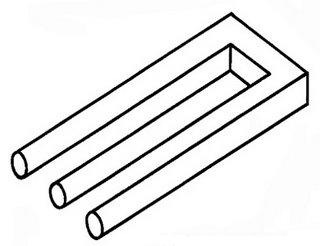The human mind is a sensory information processor. Humans receive limited sensory information and use internal methods to perceive and use the information.
To function and survive, the human mind has evolved to be able to make speedy judgments from the sensory information. The mind does a good job at this. However, it is still making guesses from incomplete information, so it comes with a margin of error. Sometimes the guesses are correct, while other times they are off.
Visual illusions are examples where perceptual guesses are wrong. Visual illusions demonstrate how the physical universe and human perception of the physical universe are different things.
Despite the appearance, the middle bar does not change in color or tone. If you cover up the image so only the bar is showing, you will see this. For those who have never before seen this image and do not know it is a visual illusion, the rational answer would be the bar changes in tone. To say it is solid in tone would defy what your eyes tell you. It is not that all false perceptions of reality are due to faulty logic, but that many are formed using what is considered sound reasoning.
,
Humans never see the entirety of an object or scene. Not only are things such as coffee cups and tree branches partially obscured by overlapping other objects, but a human doesn’t see all parts of an object at once. Even with an apple you’ve turned over in your hands, you can’t be sure whether it is fresh or rotten in the core until you bite or cut it apart. Humans live and learn in an environment where information is constantly hidden.
Ambiguity is a concept essential in understanding human beings. Caused by missing or unknowable information, ambiguity means there is more than one possible explanation for something and the person doesn’t know, and often can’t know, which if any is correct. In these circumstances, the mind picks the explanation that meets its expectations.
.
The human mind has many mental shortcuts for making speedy decisions in the face of incomplete information. These include cognitive and emotional biases, and imagination. These methods are useful, but involve arbitrariness and can result in errors in perception.
In the above left picture, you perceive a person in the lines and squiggles of the Rembrandt etching just as many do an animal in the cloud. This is an example of how the human brain organizes information into subjective recognizable patterns.
Humans judge information by comparing objects and qualities to nearby objects and qualities. These judgments by comparison can be wrong. It is the unconscious misinterpretation of the skewed diminishing scale lines that make the people appear to be of different sizes. They are the same size.
As many of the methods are automatic and unconscious, the human is unaware of them happening and often can't correct them. This leads to blindspots and biases.
Even after you learn that they are illusions, there are many visual illusions that still fool you. If you look at visual illusions in this chapter tomorrow or a year from now, they will still trick your eyes. The mind contains compartments that perform specific tasks, with many of these compartments unconscious. The perceptions of these visual illusions are formed independent of your conscious mind, and your conscious knowledge that they are illusions does not change the unconscious misperceptions.
.
Subjectivity is an integral part of the human experience, and all human perception and judgment are subjective. Love, lust, like, dislike, taste, views, aesthetic perception. A subjective experience is a product of the individual’s mind. While real and often emotionally profound, the subjective experience cannot be objectively measured by others.
When someone is listening to music, the music’s note, pitch, speed, volume and the listener’s ear vibration and heartbeat can be measured by scientific instruments. However, the listener’s aesthetic experience cannot. This experience is experienced by the listener alone. Even if asked to, the listener could not fully translate the experience to others, in part because it is beyond words and their conscious understanding.
A large range of things determines a person’s subjective perception and experience. These include genes, education, culture, personal experience, mental and physical abilities. Never forget how much your worldview, political and social and religious beliefs are influenced by your personal temperament and life history.
Humans are subjective as a species. If they were born cats, they would have different priorities and needs, and different ways of perceiving things. Human conceptions of everything are inescapably from the human perspective.
.
The human mind has evolved for survival not finding objective truths and facts. An example is when avoiding instant danger. If a threatening unidentified large shape or shadow is moving quickly at you, taking the time to gather the facts is the opposite of what you need to do. Get out of the way right away, then you can worry about identification later. This is the natural and automatic subconscious self-preservation instinct of humans.
This is just one example of how truth-finding is not always the priority of the mind and, in fact, can inhibit function. Survival is commonly said to be about erring on the side of safety, as it takes only one time being hit by a speeding car or falling off a cliff to be dead. The key word there is ‘erring.’ In this case, the mind is designed to err.
.
The human mind has limited capacity, and human function can be inhibited by too much information and even truths. To function, the mind must ignore and suppress information. If your task is to move across a room, trying to identify and learn the history and "truth” of everything and everyone in the room would lead to you dying of old age before you reach the other side. Human beings have the conscious and unconscious ability to focus, meaning they focus on some information and block out other information. The human never gets or is able to get the full picture even of what is physically visible right in front of their eyes.
The impossible trident visual illusion demonstrates how humans form perceptions by focusing on some information while ignoring other. The viewer forms a perception about the whole from looking at just one end. When she looks at the other end, she realizes her extrapolation was wrong. Unlike some visual illusions where part of the graphic is blocked and left to the imagination, there is no missing information here. All of the information is there for the eyes to see, but the viewer forms her initial perception as if information is hidden. She mentally hides, or ignores, the information herself.
.
Besides ignoring information, humans must use arbitrary rules, false beliefs, imaginary mental environments and even lies to functionally achieve. For an arbitrary or artificial rule or false idea to aid performance, the person must have faith in it.
There are regular cases where positive achievement is achieved from a false belief. These include in your daily life. Believing the false, if only temporarily, is a technique we all use to remove distracting thoughts. The following are two examples.
Though a placebo sometimes helps when the patient knows it’s a placebo, a placebo often helps because the patient falsely believes it is medicine. When this patient knows what it is, the same placebo may not help.
A student at university, Jessica is entering her final exam week before winter break. Unknown to her, the beloved family 14-year-old cat Tiger just died back home. Her parents don’t inform her that the cat has died until after the exam, as they believe knowledge will interfere with her test-taking. After a productive week, her parents break the bad news to Jessica. Jessica understands the delay, agreeing that the news would have distracted her from her studies.
In both these cases, it was a false belief that led to the desired achievement. Knowledge would have hindered. Human function often requires believing the false.
.
Humans do not perceive a direct representation of external reality, but a translation formed by their senses and brain. Human eyes and brains do a good but far from perfect job at detecting and processing light. When you look at a bowl of apples the image you see is not a direct representation of the objects, but a distorted translation created by your eyes and mind.
.
To humans, the reliability of the human mind cannot be known. A human uses its mind to judge the reliability of its mind. If your goal is to judge the accuracy of your mind, that means you do not know the accuracy of the tool used for judging (your mind).
.
Human thoughts are influenced by hard-wired survival instincts. While these instincts are important for function, they make human thought biased and myopic. Many basic assumptions-- moral norms, perceptions of category and physical structure, the truth-significance of emotional or aesthetic experiences, what is good and bad-- are formed by innate biological and emotional tendencies. People often mistake feelings for objective, universal truths.
.
In defense of humans, they are adept at functioning and making many good guesses in their daily lives. Yes, there is a margin of error and mistakes are made. However, on the whole, humans are good at doing such things such as judging distance and size, identifying objects in their daily lives, guessing how tall is a doorway, walking through a room without hitting a table or wall.
However, when one gets into the realms of philosophy, theology, and even science, the natural misperceptions, blind spots, ambiguity and inescapable illusions take on profound significance, making it impossible for humans to have objective knowledge.
.
Related articles
What Mysticism Tells Us About Human Knowledge
The Relationship Between Schizophrenia and Religious Visions
Cognitive Influences Behind Beliefs in God






Great article with terrific examples. My one objection is the explanation of “placebo”. There is no actual “placebo effect”. In reality there is regression to the mean, false attribution, error of judgement, or delusion. This is why it’s so important to have a placebo control in studies, to enable deduction of placebo data from the intervention data in order to try to calculate actual efficacy.